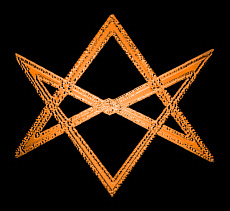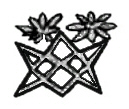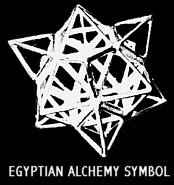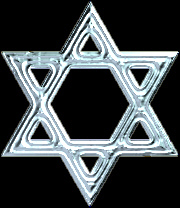
Origin of the 'Star of David'
by Betty Rhodes

 Origin of the 'Star of David' by Betty Rhodes |
 |
| WAS THIS THE ORIGINAL DESIGN FOR THE STAR OF DAVID? |
turquoise lotus blossoms & copper emblem from Sumer |
Today the Jewish 'Star of David' is called the 'Mogan David',
or the shield of David. The name 'mogan' is much too similar to
the ancient name of 'Magan' to ignore as merely a coincidence.
 According to Zecharia Sitchin, in 'The Wars of Gods and Men',
According to Zecharia Sitchin, in 'The Wars of Gods and Men',
 Magan, Egypt: Magan was an ancient region referred to in ancient Sumerian cuneiform texts, of around 2300 BCE, as a source of copper
for Mesopotamia.
The location of the original Magan is not known, but some
archaeological and geological evidence
suggests that Magan was part of what is now Oman. HOWEVER, Betty
Rhodes believes that the original 'MAGAN' was in the Sinai Peninsula
where extremely productive copper, as well as another copper related
mineral - the blue-green turquoise, mines were located. Even
today, the ruins of these old mines and tell-tale inscriptions of the
Goddess Hathor, aka ISIS - Lady of the Turquoise, can be found in the
Sinai where these ancient mines were located. Copper and turquoise
mining in the Sinai Peninsula continued until the reign of Ramses III,
and in Egypt, as well as all throughout the Mesopotamian Valley, both
minerals were highly prized and desired commodities. The
map above by Betmatrho, depicts the ancient copper trade route - notice
how it forms an inverted 'V', much like one section of the ancient
Mesopotamian Star. The precious minerals and gemstones of ancient times
have been severely under-rated when seeking the origins of word
meanings. In the Middle East, the Sumerian city-states comprised the first
great metal-using civilization. The Sumerians navigated the Euphrates
River for commerce, including the transportation of copper from Armenia
to the north. The
Sumerian word for copper, "urudu", is the same word
for the Euphrates, literally, their "copper river" trade route.
Could the 'Star of David' have originated with the ancient Egyptian
Alchemy symbol?
Magan, Egypt: Magan was an ancient region referred to in ancient Sumerian cuneiform texts, of around 2300 BCE, as a source of copper
for Mesopotamia.
The location of the original Magan is not known, but some
archaeological and geological evidence
suggests that Magan was part of what is now Oman. HOWEVER, Betty
Rhodes believes that the original 'MAGAN' was in the Sinai Peninsula
where extremely productive copper, as well as another copper related
mineral - the blue-green turquoise, mines were located. Even
today, the ruins of these old mines and tell-tale inscriptions of the
Goddess Hathor, aka ISIS - Lady of the Turquoise, can be found in the
Sinai where these ancient mines were located. Copper and turquoise
mining in the Sinai Peninsula continued until the reign of Ramses III,
and in Egypt, as well as all throughout the Mesopotamian Valley, both
minerals were highly prized and desired commodities. The
map above by Betmatrho, depicts the ancient copper trade route - notice
how it forms an inverted 'V', much like one section of the ancient
Mesopotamian Star. The precious minerals and gemstones of ancient times
have been severely under-rated when seeking the origins of word
meanings. In the Middle East, the Sumerian city-states comprised the first
great metal-using civilization. The Sumerians navigated the Euphrates
River for commerce, including the transportation of copper from Armenia
to the north. The
Sumerian word for copper, "urudu", is the same word
for the Euphrates, literally, their "copper river" trade route.
Could the 'Star of David' have originated with the ancient Egyptian
Alchemy symbol?

 'Mogan David' as the 'Shield of David'
'Mogan David' as the 'Shield of David'